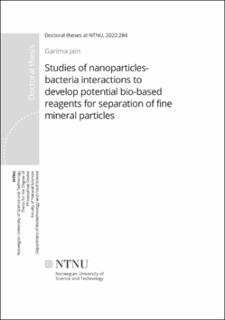| dc.contributor.advisor | Ertesvåg, Helga | |
| dc.contributor.advisor | Kota, Hanumantha Rao | |
| dc.contributor.author | Jain, Garima | |
| dc.date.accessioned | 2022-09-15T07:32:49Z | |
| dc.date.available | 2022-09-15T07:32:49Z | |
| dc.date.issued | 2022 | |
| dc.identifier.isbn | 978-82-326-5616-5 | |
| dc.identifier.issn | 2703-8084 | |
| dc.identifier.uri | https://hdl.handle.net/11250/3017943 | |
| dc.description.abstract | The increasing demand for minerals worldwide and the depletion of high-grade ores necessitate the extraction of minerals from low-grade ores. This requires processing the low-grade ores to fine and ultra-fine particles to liberate the minerals. But separating fine mineral particles via flotation is challenging and the process requires reagents with a large environmental imprint. Therefore, as an effective and eco-friendly alternative, the work in the present doctoral thesis explores the use of microbes and microbe-derived metabolites as potential reagents (biocollectors/bioflocculants) for the separation of ultrafine mineral particles.
The main work has been done on an actinomycetes bacterium Rhodococcus opacus. It has a unique cell wall structure, marked by the presence of mycolic acids (2-alkyl, 3-hydroxy fatty acids). Mycolic acids impart hydrophobicity to the cell envelope of R. opacus. Hence, the cells have been explored for separating various minerals in previous studies. But most of these studies were on micro-range minerals, but here we explored its use for the separation of minerals that are in the nano-range. In this work, the cells were genetically modified and also naturally through adaptation to the inhibitory substances to use them for mineral separation. The cells were adapted to the metal oxide nanoparticles (used as model systems for the nano-range minerals). Adapted cells showed changed surface properties, and they could be used as excellent bioflocculants for the separation of ultra-fine mineral particles. Polysaccharides are also reported to work as good flocculating agents therefore, further, we explored the flocculating potential of the fully characterized alginates from Pseudomonas fluorescens and Laminaria hyperborea, for metal oxide nanoparticles. It was found that the alginates' flocculating property depends on their composition and the cations used to form the gel. | en_US |
| dc.language.iso | eng | en_US |
| dc.publisher | NTNU | en_US |
| dc.relation.ispartofseries | Doctoral theses at NTNU;2022:284 | |
| dc.relation.haspart | Paper 1: Jain, Garima; Havskjold, Håkon; Dhar, Priyanka; Ertesvåg, Helga; Chernyshova, Irina; Kota, Hanumantha Rao. Green foam-based methods of mineral and ion separation. I: Multidisciplinary Advances in Efficient Separation Processes. American Chemical Society (ACS) 2020 ISBN 9780841237421. s. 265-301 Copyright © 2020 American Chemical Society https://doi.org/10.1021/bk-2020-1348.ch009 | en_US |
| dc.relation.haspart | Paper 2:
Jain, Garima; Slabov, Vladislav; Chernyshova, Irina; Kota,Hanumantha Rao ; Ertesvåg,Helga.
Adaptation of Rhodococcus opacus to copper oxide and iron oxide nanoparticles | en_US |
| dc.relation.haspart | Paper 3:
Jain, Garima; Ertesvåg,Helga.
Improved site-specific mutagenesis in Rhodococcus opacus 1 using a novel conditional suicide plasmid | en_US |
| dc.relation.haspart | Paper 4:
Slabov, Vladislav; Jain, Garima; Chernyshova, Irina; Kota,Hanumantha Rao ;
Alginates as green flocculants for metal oxide nanoparticles | en_US |
| dc.title | Studies of nanoparticles-bacteria interactions to develop potential bio-based reagents for separation of fine mineral particles. | en_US |
| dc.type | Doctoral thesis | en_US |
| dc.subject.nsi | VDP::Technology: 500::Food science and technology: 600 | en_US |

